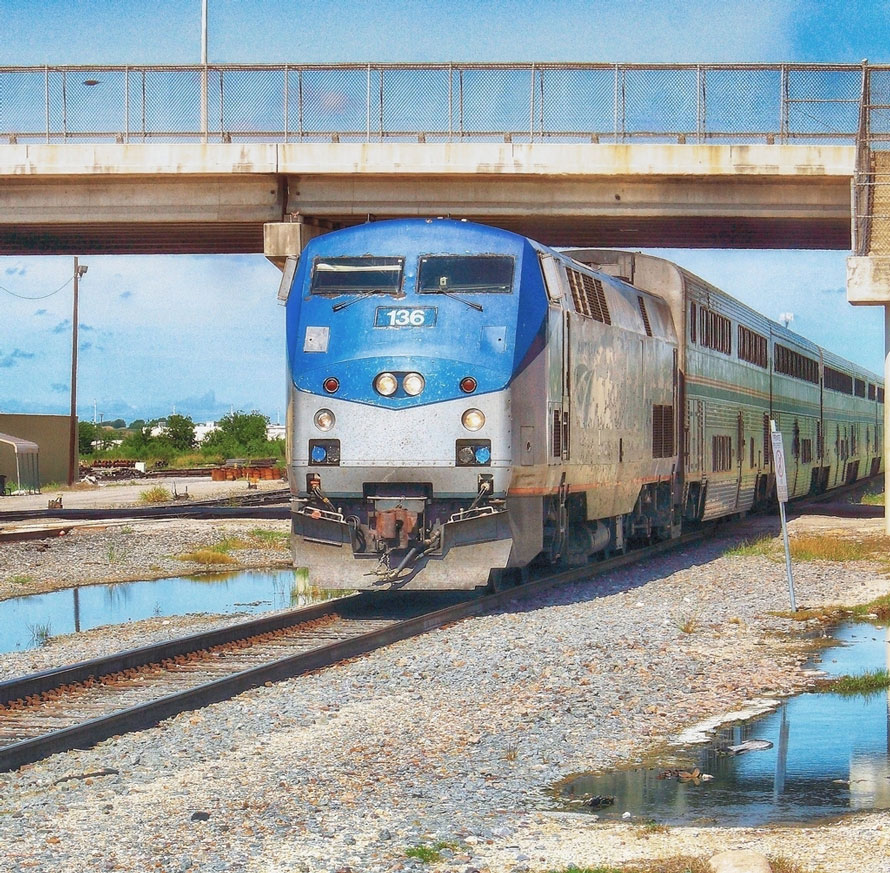
The Texas Eagle glides into Taylor, Texas. Ten-twenty-two a.m., on time, amazingly. A few passengers wait on a bleak, crumbling concrete and brick pad to embark. It is a good thing that Amtrak is on time. There are no restrooms, or other amenities. Other than a small covered space with a few picnic tables there is no waiting room for shelter from the hot Texas morning sun, not even a restroom. A far cry from the once magnificent depot that stood in the same spot. Demolished in the 1980s, it seemed then—as it still does today—that Taylor wants to separate herself from her once booming past as a major railroad junction (one of the oldest in Texas) and shipping point. For most of the 1900s, Taylor billed herself as the “Largest Inland Cotton Market in the World.”
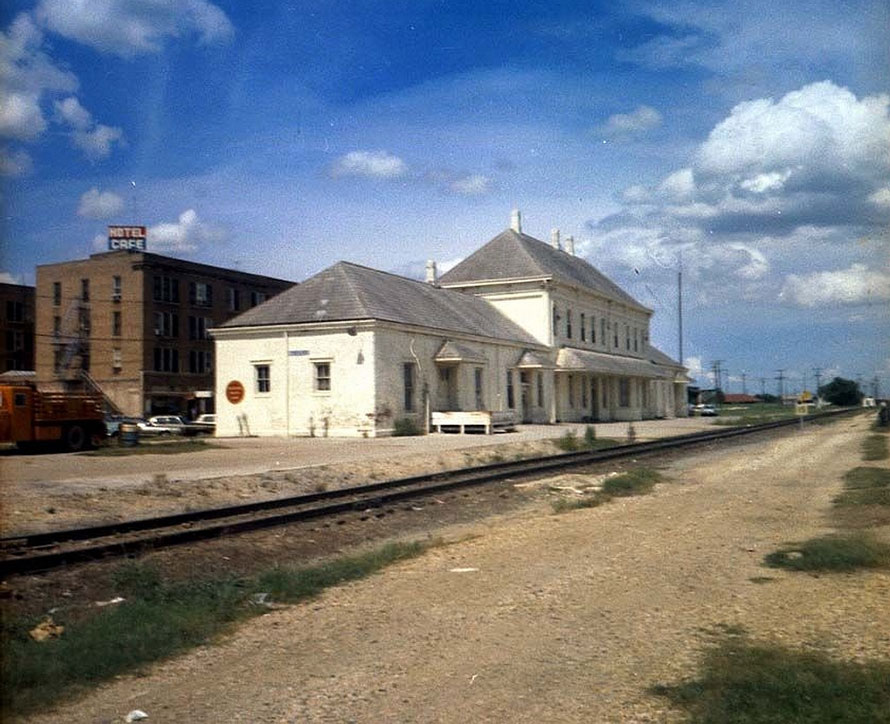
Built: 1894 Demolished: 1980s, (RJ McKay Photo, used with permission)
Not all that many years ago cotton compresses, cotton oil mills, and cotton warehouses lined the tracks. Taylor Bedding was known as the “largest mattress manufacturer in the world.” Grocery and cold storage warehouses lined First Street and the massive Swift Poultry Processing Plant was there too.
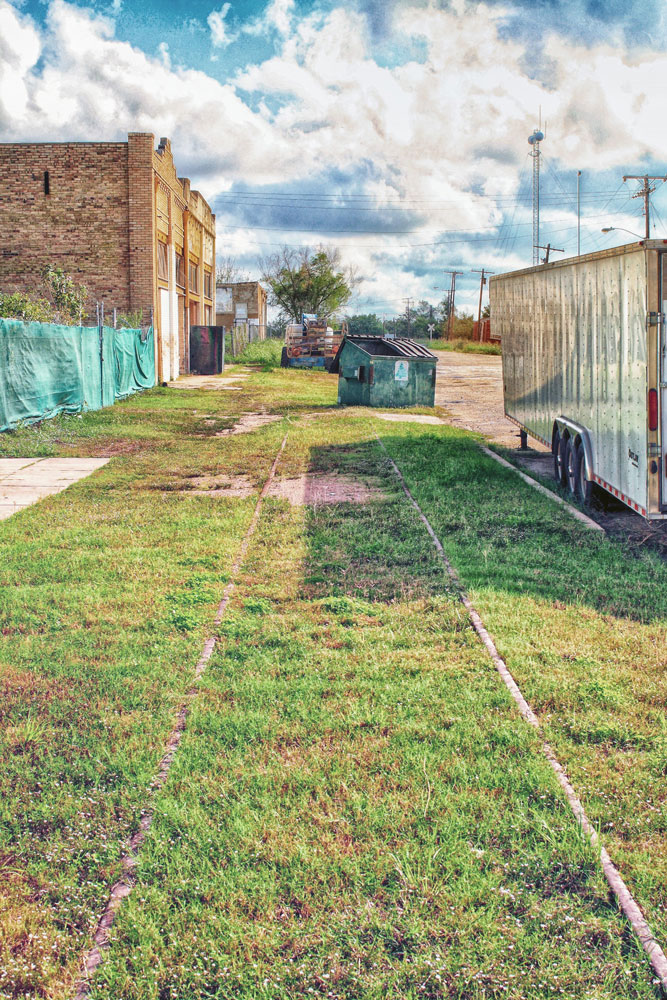
If it hadn’t had been for the arrival of the International-Great Northern Railroad (I-GN) in 1876, there would perhaps be no Taylor. Anticipating the arrival, the Texas Land Company auctioned off plots of land, priced between $350 and $420. The nascent town, as from the beginning to be a railroad town. It was even named in honor of Edward Moses Taylor, an I-GN official.
In 1886, construction on the Taylor, Bastrop and Houston Railway began, starting at Taylor and moving south towards Bastrop. Within a few months, the Missouri, Kansas and Texas Railway Company (M-K-T) (1882), wanting to build south through Taylor, purchased the Taylor, Bastrop & Houston right-of-way. By the end of 1887, Taylor was connected to Waco and Houston via the M-K-T, and to Austin and Texarkana via the I-GN. The result was the creation of one of the oldest and busiest railroad junctions in Texas.
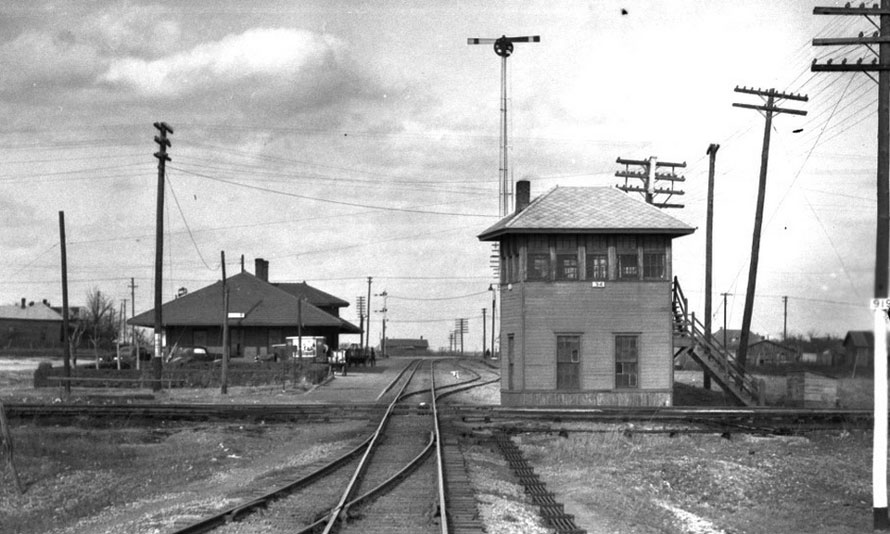
Looking north along the M-K-T mainline at the I-GN junction. The tower went into service in 1904. This photo is from the late 1930s or early 1940s. The M-K-T depot sits left of the tracks. Today a Union Pacific signal control box sits where the tower was. (John W. Barriger III, National Railroad Library, used with permission).
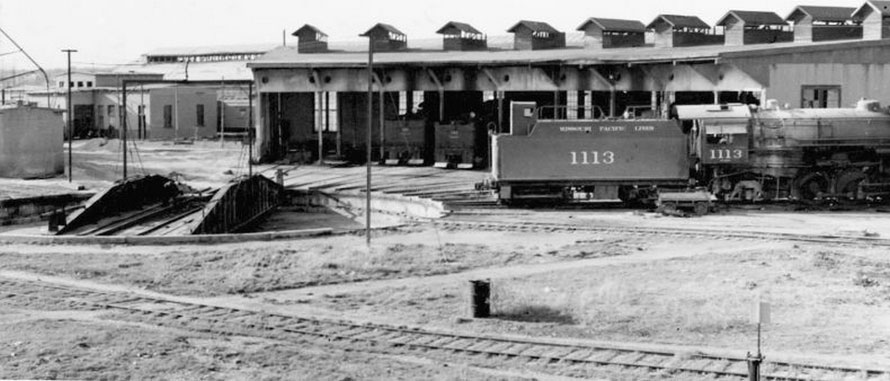
The roundhouse was apparently shared by both railroads. The locomotive in the photo is M-K-T. Sanborn Fire Maps list the roundhouse as I-GN. Photographer unknown, Taylor Public Library Collection (my scan).
Today, Union Pacific (the successor to both the I-GN/Missouri Pacific and M-K-T) has a small, but rather busy yard in Taylor serving mostly exchange traffic for the junction and a few Williamson County Grain (WmCo) sidings. Although much smaller than it once was, the cotton industry still exists. However, it no longer ships by rail.
Over the past ten years I have been taking photos of Taylor. Through those years not much has changed, especially along First Street. Even though some of these photos are dated a few years back, the scene looks pretty much the same today as it did when the photos were taken.
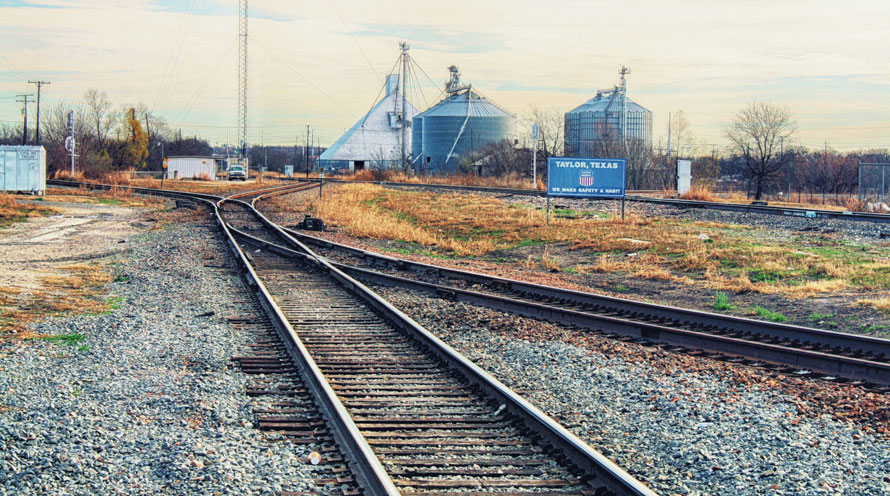
Looking east. The old I-GN/MoPac mainline is to the right of the sign. The old M-K-T mainline is just beyond the distant truck. The track in the foreground is the lead from the Amtrak “station.” The track veering to the right leads to the M-K-T mainline.
THE HUB: FIRST STREET
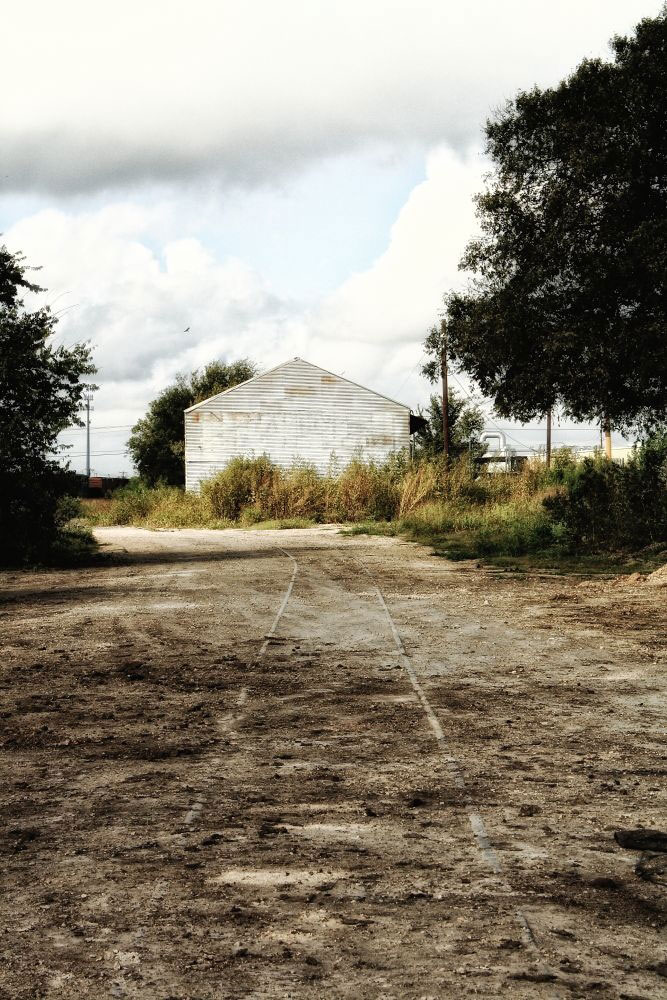
Looking west toward former Taylor Bedding Warehouse. Taylor Bedding began operation at the turn of the century. The track swerves to the left of the warehouse before merging into the yard. The land to the right once served as a feed lot. To the left were warehouses.
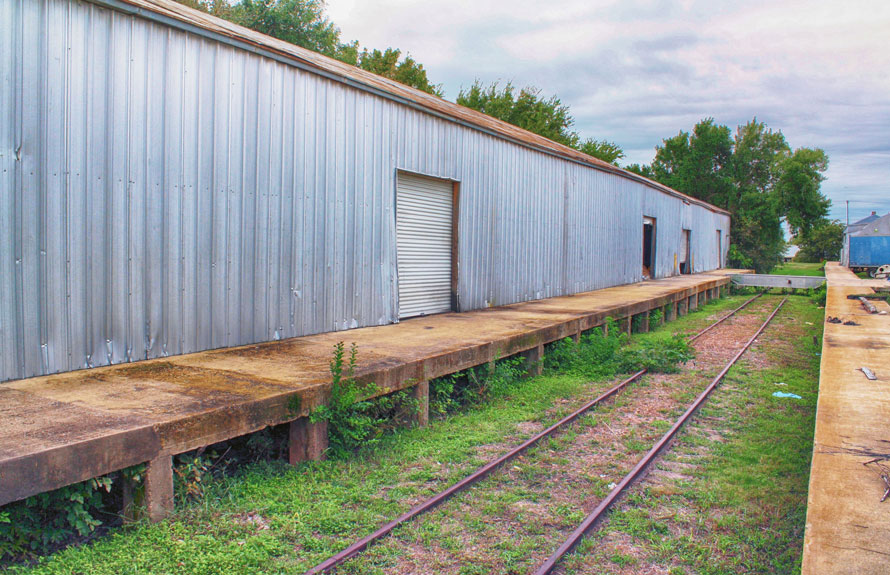
Although First Street comes to an abrupt halt at Taylor Bedding, a few of their warehouses still exist. No longer served by rail, they are used mostly for storage. There once was some talk of perhaps converting a portion of them into a distillery.
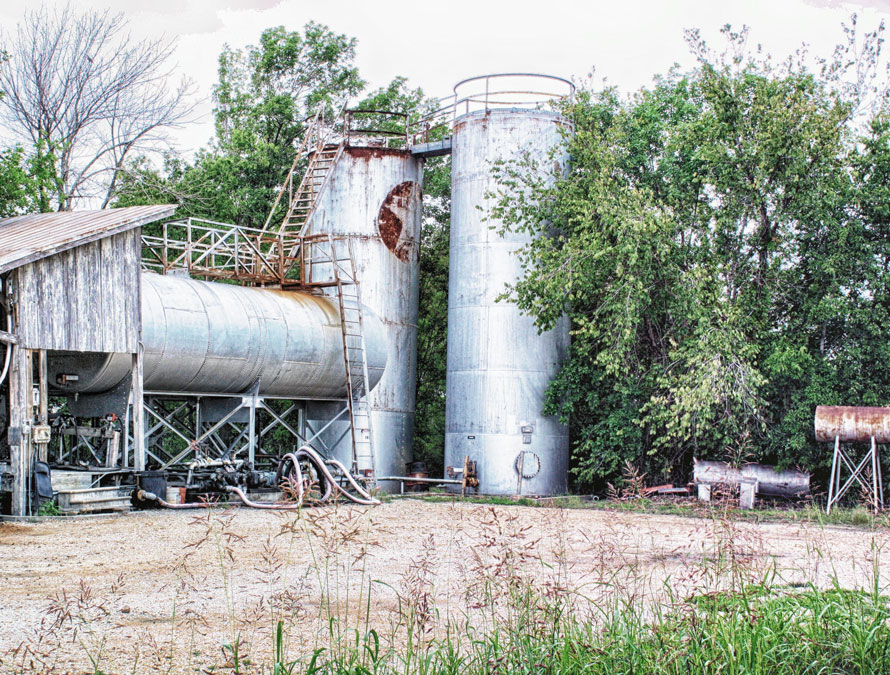
The mostly unused oil depot sits to the west just beyond the Taylor Bedding Warehouses.
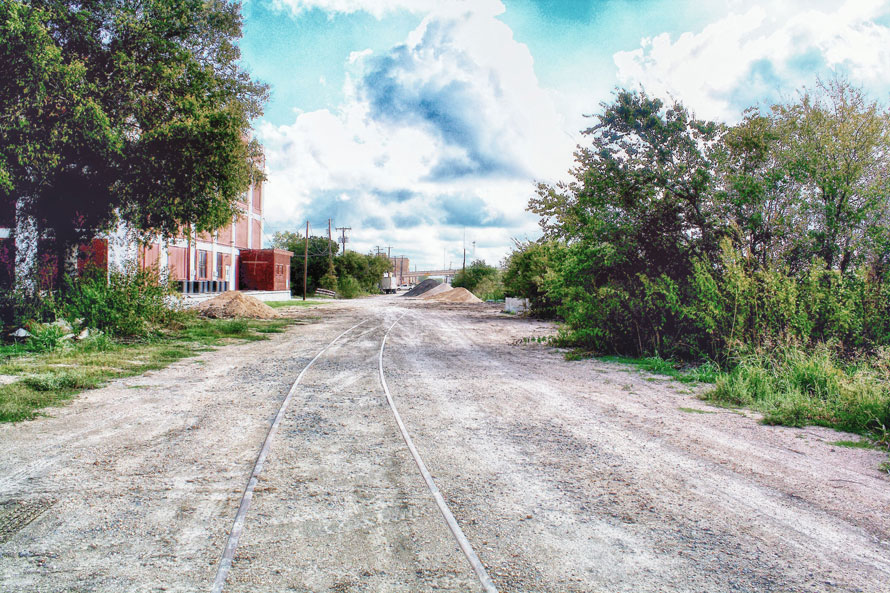
Looking east towards Main Street Viaduct (seen in the distance). The Swift Poultry & Produce Plant is to the left of the tracks. Along the right side would have once been warehouses and another Swift Poultry building. At the dirt piles in the distance, there was once a siding to the left serving a lumber yard. Today, six years later the scene looks exactly the same.
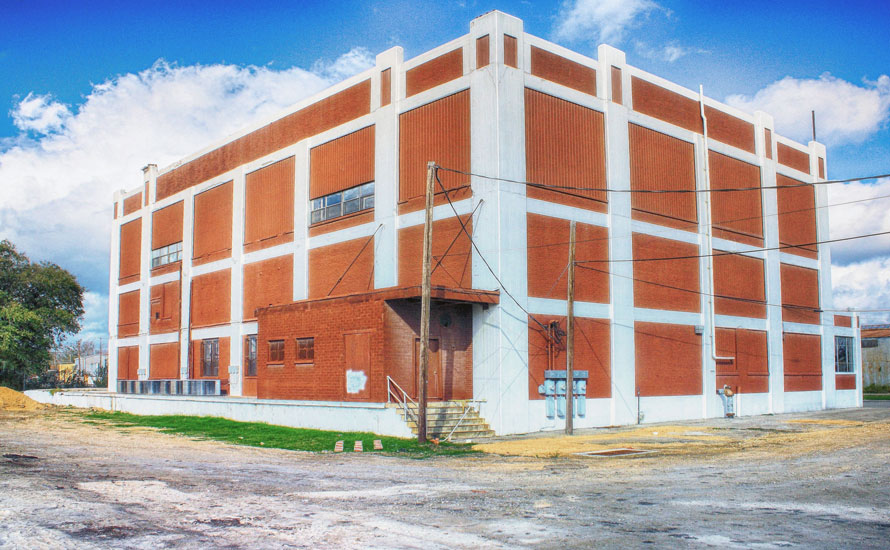
The Swift Company has been in Taylor since at least the late 1800s. Their first building, a much smaller one, was directly across the siding from this one.
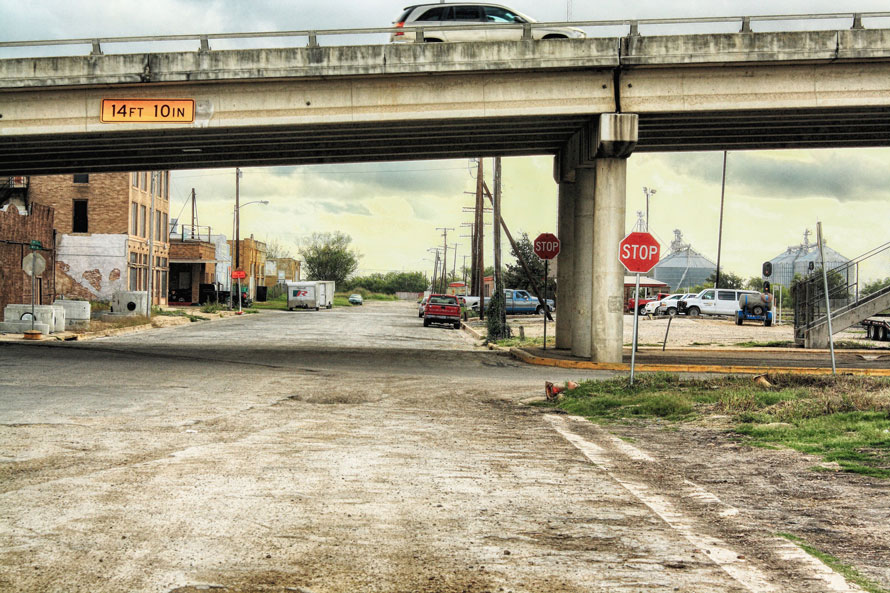
The viaduct was opened in 1972 to connect the north and south side of town. In the process, however, Taylor separated herself from the railroad and isolated several historic buildings. On the other side of the viaduct, to the right, is Taylor’s Amtrak “station.” To the left is the old Blazimar Hotel, the Blazimar garage, and the remnants of several grocery warehouses.
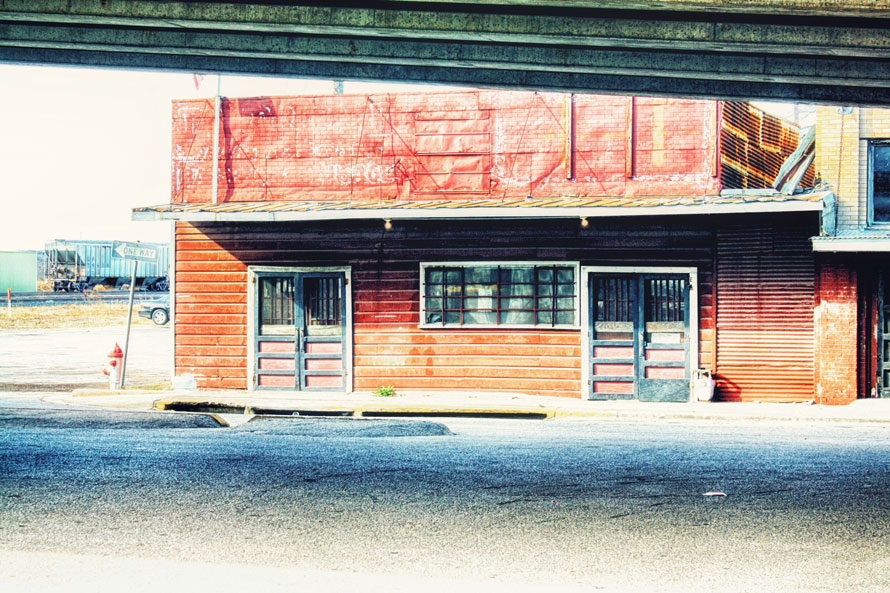
Vencil Mares purchased an old railroad hotel in 1948 and opened what was to become Taylor’s iconic BBQ joint, the Taylor Cafe. This is one of the few downtown buildings that survived Taylor’s disastrous fire of 1879. Once the streets adjacent to the tracks, First & Walnut, hosted up to 60 saloons and licit and illicit entertainment joints. The Taylor Cafe is all that remains.
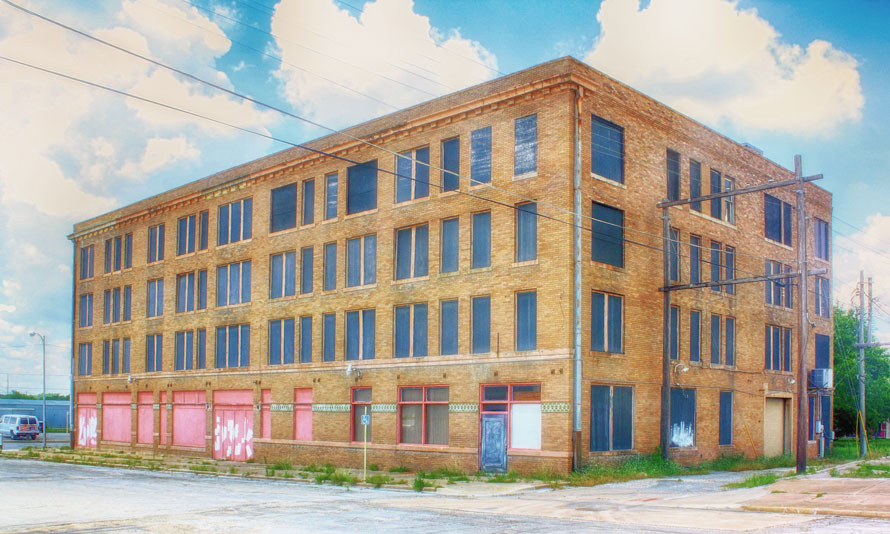
In her day, the Blazimar, directly across the street from the depot, not only served rail passengers, it was also a Taylor social center. It is claimed that Elvis Presley stayed here on his way to Camp Swift. It was also the spring home to the St. Louis Browns who once had their training camp in Taylor. The Blazimar Garage sits across Porter Street and is now home to a classic car restoration outfit.
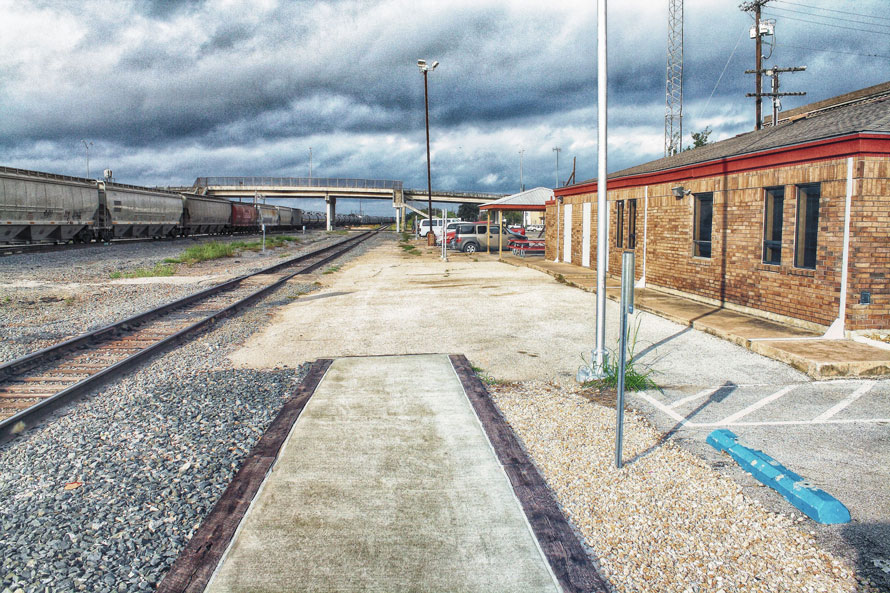
The “station” is a far cry from the stately I-GN depot that once stood on the same site. Other than a covered pavilion there are no amenities, not even a restroom, afforded those embarking or debarking an Amtrak train. The brick building is the yard office for Union Pacific. (Looking west along the old I-GN mainline.)
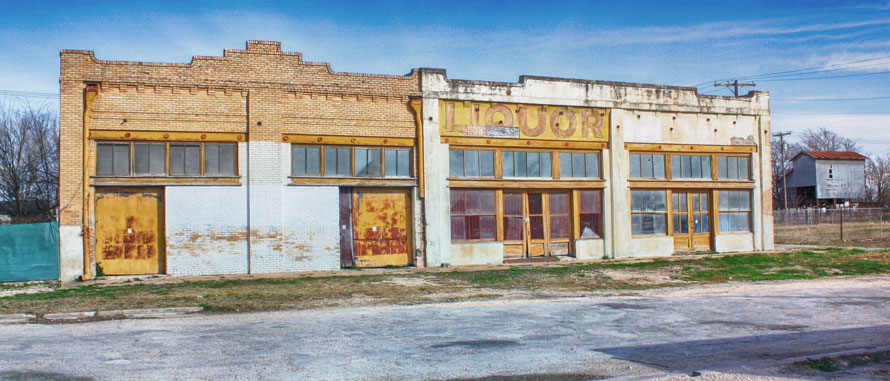
Looking across across the street from UP offices are the remains of one of the many grocery warehouses that once lined this portion of First Street. Embedded in the grass are the MKT tracks that once serviced these warehouses. These are the same warehouses in the photo looking along the M-K-T siding. Although not much about these buildings has changed today, the owner does have plans to restore them,
M-K-T WACO – HOUSTON MAINLINE
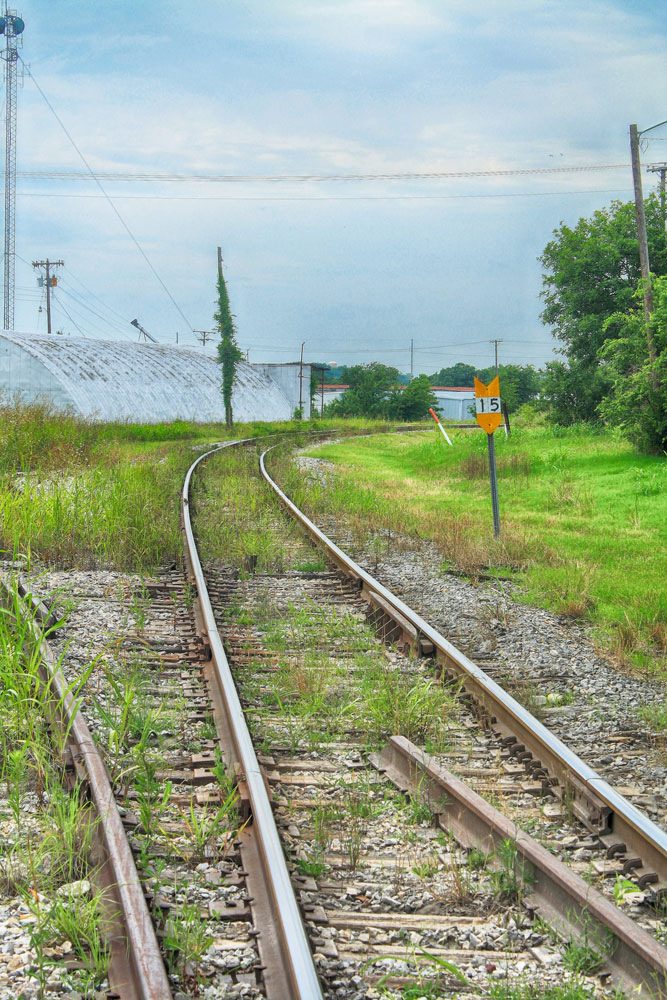
We are looking south along the I-GN juction lead. Tower 34 would have been located near where the distant electric pole stands. The Quonset hut-like building in the distance sits about where the MKT freight station would have been. The depot would have been to the left of that building along the main line.
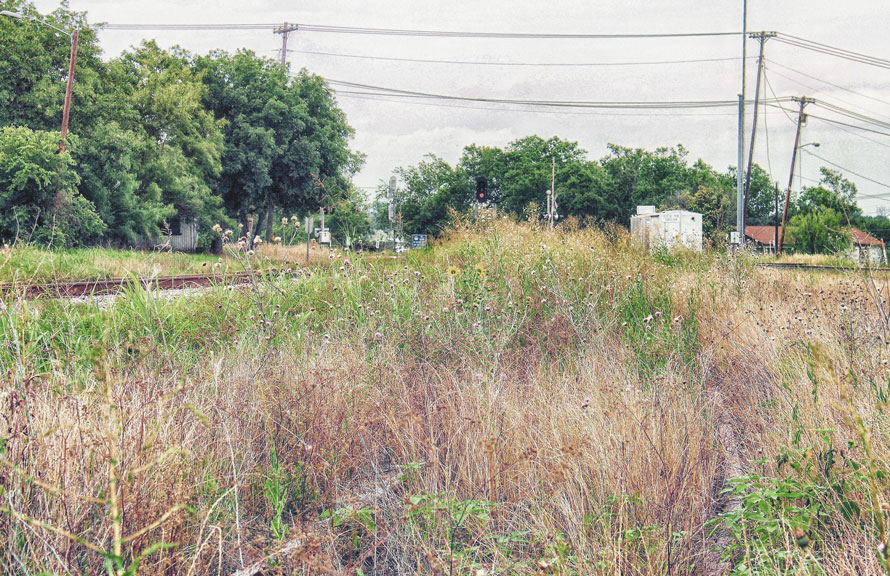
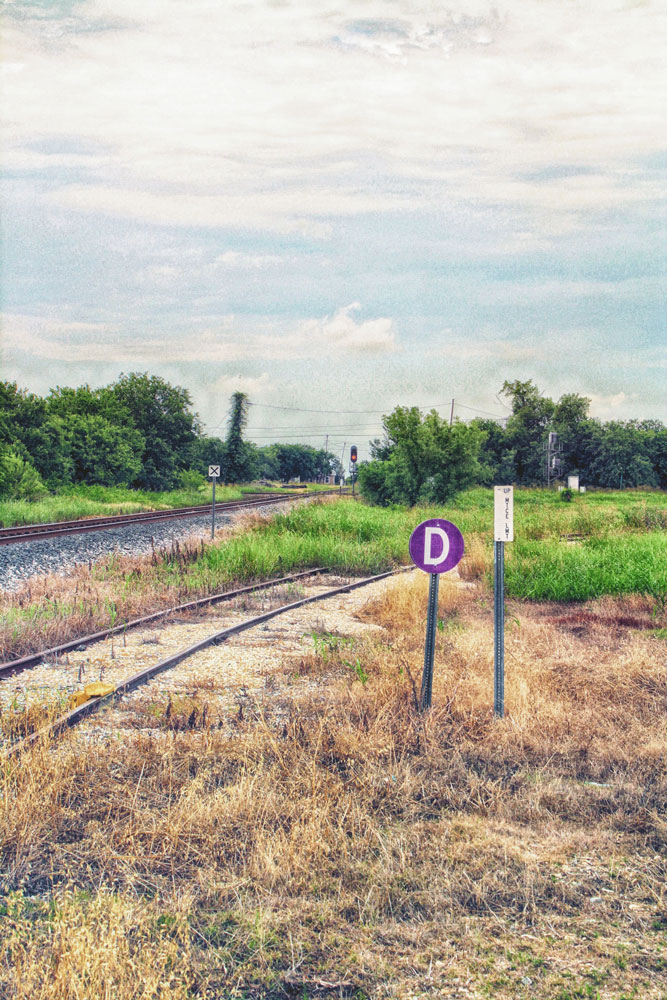
If we follow (not advised) the path south along the old M-K-T mainline to Martin Luther King Blvd., we come to the Williamson County Grain Company (WmCo). This image looks north toward the junction. The siding is to the old Travis Cotton Oil Mills, now part of WmCo. WmCo is one of the few Taylor industries, perhaps the only one, that still ships by rail.
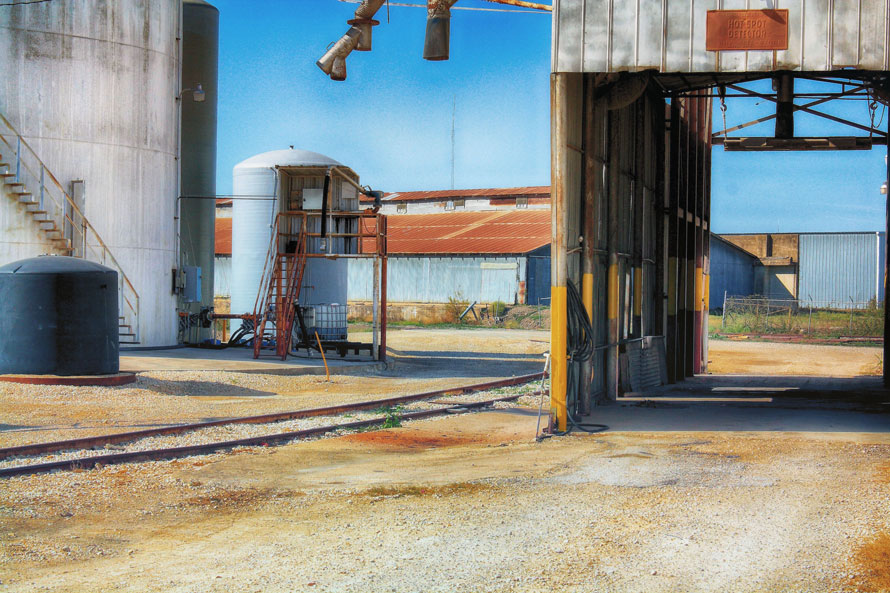
The warehouses in the rear of image are Taylor Compress cotton warehouses.
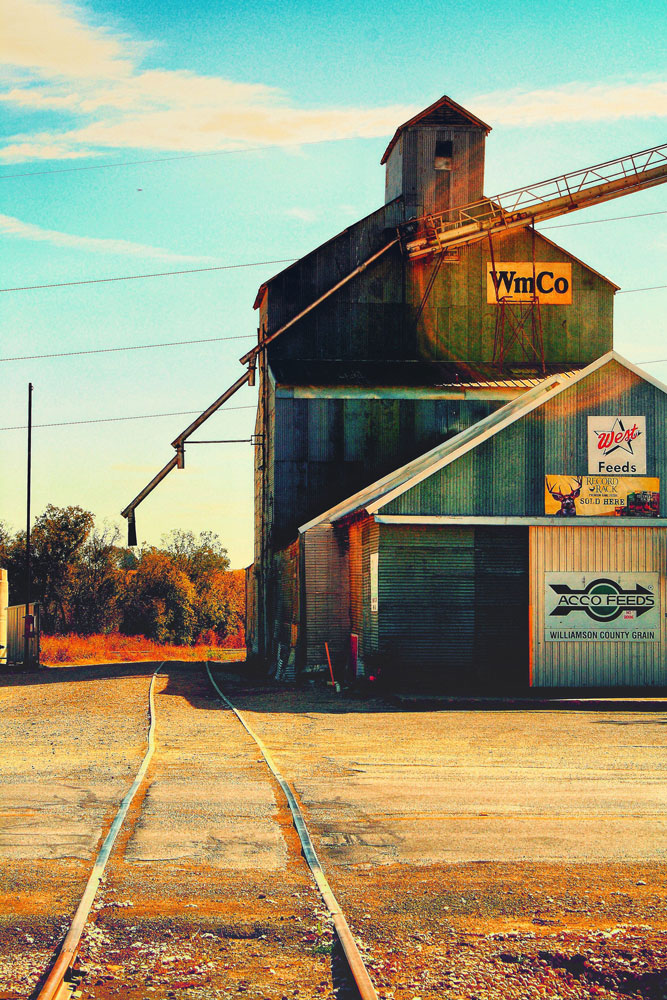
The track is a siding off the M-K-T (2018)
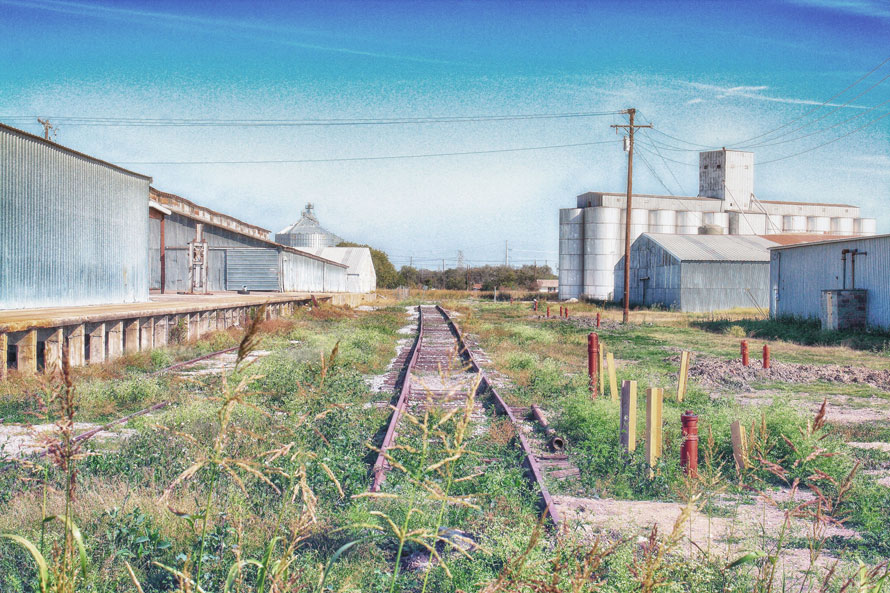
The grain elevators are Williamson County Grain. These siding were served by both the I-GN & M-K-T
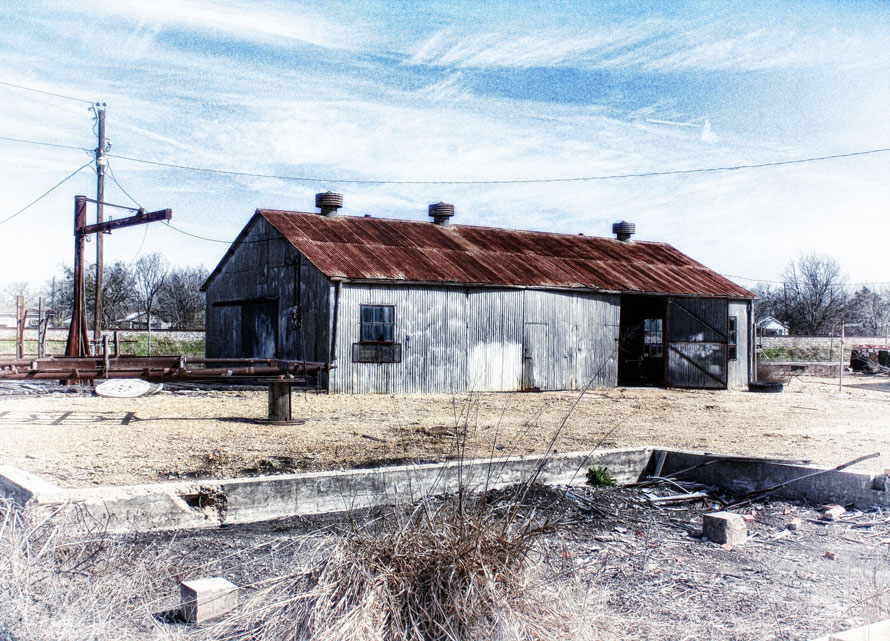
The siding comes off of the I-GN tracks in background
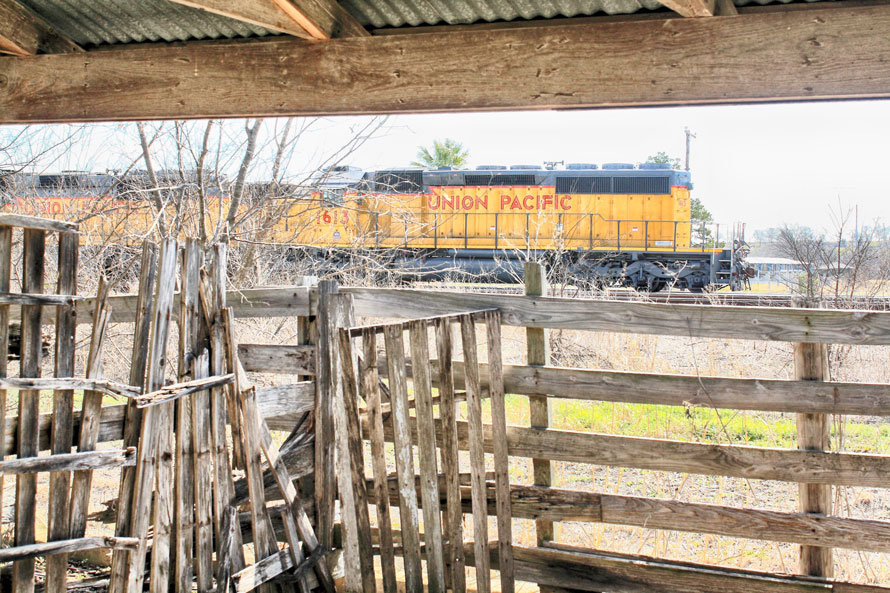
This small stockyard off the I-GN served a meat processing plant. The plant is still in business, although it no longer does any butchering of live animals. Although the siding has been removed its location is still visible. The M-K-T had a larger stock yard south of town.
Note: Sanborn Fire Maps for Taylor are available as part of the University of Texas Perry-Castañeda Library Map Collection (https://legacy.lib.utexas.edu/maps/sanborn/texas.html).
Frank Mills – Copyright 2019
https://www.frankamills.com
Well done post, Frank. Excellent photos with just enough detail to take one back to ‘the days’. Those remaining tracks along the buildings and in the streets still come alive in one’s imagination!
Thank you, Morgan. I have long thought that First Street, either in its heyday, or as it is now, would make a great model diorama.
such a sad story, but so true. You see this all over America when you travel. Very well done great pictures
Thank you, John.
Hi, Frank
Your excellent photographic skills and immense writing creativity are both very well shown in this excellent piece. As is your fondness for Taylor, which I have long admired and appreciated. Thank you for adding to the fabric of Taylor in such a huge way. I hope this article and pictorial are appropriately archived at the Taylor Public Library and at City Hall.
For many years my maternal grandfather Thomas Duffy was also a deeply rooted part of Taylor’s heyday fabric. He owned Taylor Drug Store, which also included a package store under the same roof. What a high-energy gathering place that was for decades on South Main Street, just south of the railroad tracks. Your article and pictures brought back tons of very sweet childhood memories of visiting “Bop” at his store, often waiting for “hours” for the train to pass (no overpass long, long ago). But we were kids and we didn’t mind. We weren’t glued to any corporate schedule, and we would make a game out of counting the railroad cars as they slowly passed in sleepy downtown Taylor.
Plus the anticipation of seeing Bop again, whose engaging Irish smile charmed us even at the time. He sometimes would let us get some hard candy out of one of his display cases, which added to the anticipation.
Job very well done, Frank, and thanks!
Jimmy Aanstoos
Thank you, Jimmy! I always enjoy hearing how a one of my images or a photo-essay brings back fond memories. I can identify with those memories from my own childhood, going to visit my grandparents. No candy store to add to the anticipation though.
Enjoyable collection. If only the walls of that old hotel could talk !
Thank you, Greg. I am hoping to get permission to get inside the hotel and take some photos. There is a story in my mind about a drummer (traveling salesman) who spreads out his wares to sell in one of the rooms in the Blazimar set aside just for that.
Am curious if you have uncovered any archived photos from the original station? I am particularly intrested in the interior.
Barbara, at this point in time I have not. That said, I have not really dug through either the Taylor Library’s or the Williamson County Museum’s collections. Hopefully, one of these days maybe I can find some time to do so. I will ask RJ McKay who took the depot that I included. Maybe he took some, or knows of some. Thanks for asking.
(I guess my first reply didn’t take as I don’t see it.) I have not uncovered any images of the interior. There may however be same in either Taylor Library’s collection, or that of the Williamson County Museum. Hopefully, one day I can find the time to did through these collections. It is possible that R.J. McKay (whose depot photo I used) has some. I will ask. And thank you for taking time to go through the essay and comment.
thank you. I ask because a friend of mine bought all the beautiful long leaf pine from the depot in early 80’s.
If I find out something I will let you know.
Hello Frank
Enjoyed your pics. I own the old Allison lake (railroad lake and Flagg springs across 4th st. Would love some pics and history of these. Thanks. Josh woodsman.com@me.com